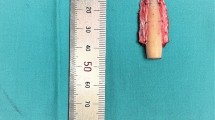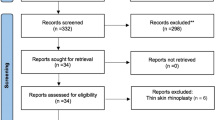Abstract
Introduction
This randomized controlled study aimed to analyse the long-term results of thin-skinned patients who underwent rhinoplasty.
Materials and Methods
All the included study patients had the following characteristics: underwent primary rhinoplasty for functional and/or cosmetic problems, were thin-skinned, had been followed for almost 2 years, underwent both standard pre- and post-operative photography, had a good understanding of the Italian language, and had signed a consent form for inclusion in the study. The patients were randomly divided into 4 groups as follows: group 1, camouflage of the dorsum by diced cartilage; group 2, camouflage of the dorsum with lipofilling; group 3, camouflage of the dorsum by a temporal fascia graft; and group 4 (control group), without camouflage of the dorsum. Patients answered the Italian version of the FACE-Q rhinoplasty module. The Obagi skin pinch test was used to measure nasal skin thickness. We compared pre- and post-operative patient satisfaction with the appearance of their nose between the 4 patient groups by the Chi-squared test for unpaired data. Two plastic surgeons reviewed all the post-operative photographs of the study patients and rated the photographs on a scale of 1 to 5.
Results
A total of 101 patients who underwent primary rhinoplasty between January 2016 and March 2018 in our department of plastic surgery and satisfied the inclusion criteria were enrolled in this study. The mean patient age was 38.5 years. The mean follow-up time was 2.5 years. The differences between the preoperative and post-operative FACE-Q values for group 1 were significant (P < 0.01), whereas the differences between the preoperative and post-operative FACE-Q values for the other groups were not significant. The results for group 1 patients remained stable over the long-term follow-up compared with the results for other groups (P < 0.01). Groups 2 and 4 underwent more secondary procedures than groups 1 and 3 (P < 0.01). The 2 reviewers determined that patient groups 1 and 3 obtained more satisfactory outcomes than groups 1 and 4 (P < 0.01).
Conclusions
This was the first randomized study to demonstrate that diced cartilage grafts used for thin-skinned patients was the best approach for obtaining a satisfactory long-term outcome and durable natural appearance.
Level of Evidence I
This journal requires that authors assign a level of evidence to each article. For a full description of these Evidence-Based Medicine ratings, please refer to the Table of Contents or the online Instructions to Authors www.springer.com/00266.






Similar content being viewed by others
Change history
08 June 2020
The authors of this article wish to make the following clarification: The FACE-Q is a trademarked patient reported outcome instrument. The “Satisfaction with Nose” scale described and reproduced in this article is similarly trademarked; the copyright is retained by the Q-Portfolio. If readers would like to use the FACE-Q in research or clinical practice, they are directed to www.qportfolio.org to obtain a license permission from the copyright holders. Reproduction of the FACE-Q in publications without prior permission is not permitted.
References
American Society of Plastic Surgeons (2014) Plastic surgery statistics. [cited 2014] https://www.plasticsurgery.org/news/plastic-surgerystatistics?sub=2018+Plastic+Surgery+Statistics
Rohrich RJ, Ahmad J (2016) A practical approach to rhinoplasty. Plast Reconstr Surg 137:725e–746e
Tardy ME (1997) Rhinoplasty: the art and science. W.B. Saunders, Philadelphia
Tardy ME, Thomas JR (2008) Our personal approach and philosophy. In: Becker DG, Park SS (eds) Revision rhinoplasty. Thieme, New York, pp 202–222
Johnson CMJ, Godin MS (1995) The tension nose: open structure rhinoplasty approach. Plast Reconstr Surg 95:43–45
East C, Kwame I, Hannan SA (2016) Revision rhinoplasty: what can we learn from error patterns? An analysis of revision surgery. Facial Plast Surg 32(4):409–415
Calvert JW, Patel AC, Daniel RK (2014) Reconstructive rhinoplasty: operative revision of patients with previous autologous costal cartilage grafts. Plast Reconstr Surg 133:1087–1096
Kridel RW, Soliemanzadeh P (2006) Tip grafts in revision rhinoplasty. Facial Plast Surg Clin North Am. 14(331–41):vi
Cho GS, Kim JH, Yeo NK, Kim SH, Jang YJ (2011) Nasal skin thickness measured using computed tomography and its effect on tip surgery outcomes. Otolaryngol Head Neck Surg 144:522–527
Barone M, Cogliandro A, Cassotta G, Signoretti M, Di Stefano N, Tambone V, Persichetti P (2018) Rhinoplasty in elderly patients: analysis of outcomes and patient’s satisfaction following 20 years experiences. Eur J Plast Surg 41:395. https://doi.org/10.1007/s00238-017-1387-7
Barone M, Cogliandro A, Salzillo R, List E, Panasiti V, Tenna S, Persichetti P (2019) Definition of “gender angle” in Caucasian population. Aesthetic Plast Surg 43(4):1014–1020
Marianetti TM, Grussu F, Cervelli D, Gasparini G, Pelo S (2014) Equine pericardium membrane to prevent dorsal irregularities in rhinoplasty. Ann Plast Surg 73(2):128–130
Öreroğlu AR, Çakir B, Akan M (2014) Bone dust and diced cartilage combined with blood glue: a practical technique for dorsum enhancement. Aesthet Plast Surg 38(1):90–94
Guerrerosantos J, Trabanino C, Guerrerosantos F (2006) Multifragmented cartilage wrapped with fascia in augmentation rhinoplasty. Plast Reconstr Surg 117(3):804–812
Gryskiewicz J (2008) Dorsal augmentation with AlloDerm. Semin Plast Surg 22(2):090–103
Cerkes N, Basaran K (2016) Diced cartilage grafts wrapped in rectus abdominis fascia for nasal dorsum augmentation. Plast Reconstr Surg 137(1):43–51
Stoll W (1991) The use of polytetrafluoroethylene for particular augmentation of the nasal dorsum. Aesthet Plast Surg 15(1):233–236
Chang C, Kong WK (2014) Clinical effectiveness and safety of collagen sheet for dorsal augmentation in rhinoplasty. J Craniofac Surg 25(5):1852–1854
Toriumi DM (2017) Dorsal augmentation using autologous costal cartilage or microfat-infused soft tissue augmentation. Facial Plast Surg 33(2):162–178
Karaaltn MV, Batoglu-Karaaltn A, Orhan KS, Demirel T, Guldiken Y (2012) Autologous fascia lata graft for contour restoration and camouflage in tertiary rhinoplasty. J Craniofac Surg 23:719–723
Oreroğlu AR, Cakır B, Akan M (2014) Bone dust and diced cartilage combined with blood glue: a practical technique for dorsummenhancement. Aesthetic Plast Surg 38(1):90–94
Codazzi D, Ortelli L, Robotti E (2014) Diced cartilage combined with warm blood glue for nasal dorsum enhancement. Aesthetic Plast Surg 38(4):822–823
Obagi ZE (2014) The art of skin health restoration and rejuvenation, 2nd edn. CRC Press, London
Barone M, Cogliandro A, Di Stefano N, Aronica R, Tambone V, Persichetti P (2017) Linguistic validation of the “FACE-Q Rhinoplasty Module” in Italian. Eur Arch Otorhinolaryngol 274(3):1771–1772
Klassen AF, Cano SJ, East CA, Baker SB, Badia L, Schwitzer JA, Pusic AL (2016) Development and psychometric evaluation of the FACE-Q scales for patients undergoing rhinoplasty. JAMA Facial Plast Surg 18:27–35
Schwitzer JA, Sher SR, Fan KL, Scott AM, Gamble L, Baker SB (2015) Assessing patient-reported satisfaction with appearance and quality of life following rhinoplasty using the FACE-Q appraisal scales. Plast Reconstr Surg 135(5):830e–837e
Barone M, Cogliandro A, Di Stefano N, Tambone V, Persichetti P (2017) A systematic review of patient-reported outcome measures after rhinoplasty. Eur Arch Otorhinolaryngol 274(4):1807–1811
Kosins AM, Obagi ZE (2017) Managing the difficult soft tissue envelope in facial and rhinoplasty surgery. Aesthet Surg J 37(2):143–157
Ilhan AE, Sozen T, Caypinar Eser B, Cengiz B (2017) Association of skin thickness with alar base reduction in patients undergoing lateral crural repositioning and strut grafting. JAMA Facial Plast Surg 19(6):516–521
Chauhan N, Sardesai MG, Burchard AE, Ellis DA (2010) Nasal tip refinement: analysis of surgical technique, efficacy, and secondary effect of skin thickness. Aesthet Surg J 30(1):39–43
Aldosari B (2019) Is nasal skin thickness a prognostic indicator to postoperative edema and ecchymosis? Ear Nose Throat J 29:145561319868452
Hafezi F, Naghibzadeh B, Nouhi A (2006) Management of the thick-skinned nose: A more effective approach. Ann Otol Rhinol Laryngol 115(6):444–449
Farrior EH, Ballert JA (2012) Nuances of the nasal tip: rhinoplasty of the thin-skinned nose. Facial Plast Surg 28(2):171–176
Gode S, Ozturk A, Kısmalı E, Berber V, Turhal G (2019) The effect of platelet-rich fibrin on nasal skin thickness in rhinoplasty. Facial Plast Surg 35(4):400–403
Gode S, Ozturk A, Berber V, Kısmalı E (2019) Effect of injectable platelet-rich fibrin on diced cartilage’s viability in rhinoplasty. Facial Plast Surg 35(4):393–396
Hanci D, Üstün O, Kumral TL, Ahmed EA, Uyar Y (2019) Camouflage of the nasal dorsum in thin-skinned patients with diced cartilage combined with a new cross-linked hyaluronan (NCH) gel and blood: a new method. Aesthetic Plast Surg 43(3):786–792
Alharethy S, Mousa A, Alharbi A, Aldrees T, AlQaryan S, Ju Jang Y (2018) Does skin thickness affect satisfaction post rhinoplasty? Middle Eastern population as an example. Saudi Med J 39(12):1238–1241
Cobo R, Camacho JG, Orrego J (2018) Integrated management of the thick-skinned rhinoplasty patient. Facial Plast Surg 34(1):3–8
Davis RE, Hrisomalos EN (2018) Surgical management of the thick-skinned nose. Facial Plast Surg 34(1):22–28
Botti G (1996) Thick skin and cosmetic surgery of the nasal tip: how to avoid the cutaneous polly beak. Aesthetic Plast Surg 20(5):421–427
Klatsky SA, Manson PN (1983) Aesthetic rhinoplasty in patients with thick nasal skin. Ann Plast Surg 11:10–16
Hafezi F, Naghibzadeh B, Nouhi A (2006) Management of the thick skinned nose: a more effective approach. Ann Otol Rhinol Laryngol 115(06):444–449
Kreutzer C, Hoehne J, Gubisch W, Rezaeian F, Haack S (2017) Free diced cartilage: a new application of diced cartilage grafts in primary and secondary rhinoplasty. Plast Reconstr Surg 140(3):461–470
Limberg AA (1961) The use of diced cartilage by injection with a needle: part 1. Clinical investigations. Plast Reconstr Surg 28(5):523–536
Daniel RK (2008) Diced cartilage grafts in rhinoplasty surgery: current techniques and applications. Plast Reconstr Surg 122(6):1883–1891
Peer AL (1943) Diced cartilage grafts. Arch Otolaryngol 38:156
Erol OO (2000) The Turkish delight: a pliable graft for rhinoplasty. Plast Reconstr Surg 105(6):2229–2241
Author information
Authors and Affiliations
Corresponding author
Ethics declarations
Conflict of interest
The authors declare that they have no conflicts of interest to disclose.
Ethical Standard
This article does not contain any studies with human participants or animals performed by any of the authors.
Informed Consent
Informed consent related to the photography was required of every study patient, which included permission for publication.
Additional information
Publisher's Note
Springer Nature remains neutral with regard to jurisdictional claims in published maps and institutional affiliations.
Rights and permissions
About this article
Cite this article
Barone, M., Cogliandro, A., Salzillo, R. et al. The Role of Skin Thickness in the Choice of a Rhinoplasty Technique for Thin-Skinned Patients: Analysis of Long-Term Results and Patient Satisfaction. Aesth Plast Surg 44, 1742–1750 (2020). https://doi.org/10.1007/s00266-020-01763-6
Received:
Accepted:
Published:
Issue Date:
DOI: https://doi.org/10.1007/s00266-020-01763-6




